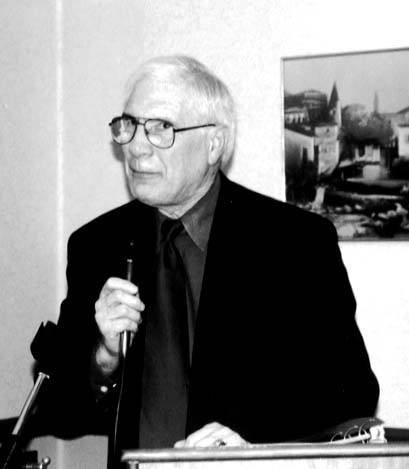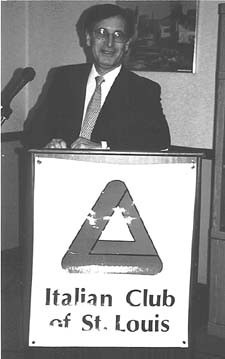|

FEBRUARY MEETING
Lyon: A Roman City
|
| presented by Salvatore Sutera, Ph.D.
Julius Caesar invaded Gaul (modern France) in 58 BC,
establishing a military camp on high ground near the confluence of two
great rivers known today as the Rhône and the Saône.
In eight years, Caesar completed the conquest of Gaul and the pacification
of some 60 Celtic tribes inhabiting the region. A Roman colony named
Lugdunum was founded on the site of the military camp in 43 BC. The emperor
Augustus came to Lugdunum in 16 BC, spent two years there and designated
the city as the capital of the three provinces of Gaul. The future
emperor Claudius was born there in 10 BC.
Lugdunum grew steadily and was embellished by Roman emperors, especially
Augustus and Hadrian reaching its zenith during the two-century period
known as the Pax Romana (69 – 192 AD).
Around 270 AD the Gallic tribes began to revolt and the
death throes of glorious Lugdunum began. The history of Lyon’s evolution
and its physical characteristics during the Roman era were very well hidden
as a consequence of wholesale destruction followed by many centuries of
overlying construction. Many key discoveries did not occur until
well into the 20th century. The martyrdom of six Christians, including
a courageous young virgin who became Saint Blandine, in 177 AD, provided
an important key to one of the lingering puzzles of the geography of ancient
Lugdunum. The slide presentation will review the birth and ascent of Lugdunum
to greatness under the Romans and cover some of the spectacular vestiges
that may be seen today.
Salvatore Sutera, Ph.D. is the Spencer T. Olin Professor
of Biomedical Engineering at Washington University, President of the St.
Louis-Lyon Sister City organization and an Italian Club member.
|
|
Next Meeting Wednesday, March 19, 2003
Cocktails 6:30 PM - Dinner 7:00 PM
Da Baldo's Restaurant
RSVP Marie Wehrle
(314) 544-8899
or by email
|

RECAP OF JANUARY MEETING
Gabriele D'Annunzio and His Vittoriale
|
 Anthony Perrone and Eugene Mariani gave most interesting presentations
about Gabriele D'Annunzio. He is considered to be one of the most
influential, eccentric and controversial Italian writers of the early 20th
century.
Anthony Perrone and Eugene Mariani gave most interesting presentations
about Gabriele D'Annunzio. He is considered to be one of the most
influential, eccentric and controversial Italian writers of the early 20th
century.
Born in Pescara, Abbruzzi, March 12, 1863, he showed early signs of
being precocious. He attended the Ginnasio del Reala Collegio
“Cicogini” in Prato. Later he attended the University of
Rome. He was an early success as a writer, a man of letters.
He lived his art! At this stage of his early career, D’Annunzio’s
poetry, drama and prose becomes daring, intellectually suggestive, and
linguistically and conceptually elegant. Although his personal life
is tumultuous with countless mistresses and many wives.
From 1907 through 1915 D’Annunzio lived in Paris in self
imposed exile. His writings are prolific yet he cannot keep ahead
of his creditors. He returns to Italy in May of 1915 and shortly
thereafter, Italy declares war on Austria. At age 52 D’Annunzio enlists
in the Italian military as a cavalry lieutenant. During the three
years of the war, he participated in some of the most daring acts of combat
on land, sea and air. He lost an eye in a plane crash. Because
of his heroic exploits, his notoriety reaches the heights of superhuman
proportions. Bedridden for months, he dictated to his daughter, Renata,
from his hospital bed, a book of poems and two reflective memoirs.
After the war, D’Annunzio was decorated with the highest
honor that Italy could bestow, including, La Medaglia d’Oro al Valore
Militare ! With the rise of Fascism, D’Annunzio become an idol.
He represented the complete manifestation of Fascism, without he himself
becoming a Fascist !
Furious with the Allies’ decision not to have the city
of Fiume annexed to Italy, he takes matters in his own hands. At
the head of thousands of Legionari , known as Arditi, beset
with high fever, D’Annunzio leaves the city of Ronchi on September 1, 1919
and occupies Fiume in Croatia, against the wishes of the Italian government.
Sixteen months later, the Italian government pressured by the Allies sends
forces to Fiume under General Caviglia to end D’Annunzio’s regime.
To avoid bloodshed, D’Annunzio surrenders the city and evacuates, embittered
and disillusioned by the experience.
In 1922 he purchases Villa Caragnacco on the shores of
Lago di Garda. Eventually, he renovates and builds additions to the
property, renaming it, Il Vittoriale d’Italia!
Mussolini and his fascists march on Rome in 1923 and take over the
government, Il Duce, becomes the dictator of Italy. Courted and feared
by Mussolini, D’Annunzio is virtually kept under house arrest at Il Vittoriale.
Living with his last lover, Luisa Beccaria, D’Annunzio dedicates himself
to decorating his estate.
Virtually kept under house arrest at Il Vittoriale.
Living with his last lover, Luisa Beccaria, D’Annunzio dedicates himself
to decorating his estate. The Vittoriale is not a house but an estate
of 22 acres. In actuality, it is a small town with its own piazza.
The main house, La Prioria was originally known as Villa Cargnacca.
The floor plan of the manor consists of rooms with interesting names, Corridor
of the Way of the Cross, The Monk’s Scriptorium, Veranda of the Little
Apollo, Room of the Lily, etc.
The vestibule, although architecturally not impressive
gives an interesting insight into D’Annunzio’s style of dealing with people.
At the landing there are two doors– one to the left and the other to the
right– leading to two waiting rooms. The left room, Oratorio Dalmata,
is for visiting close friends. Suspended from the ceiling is a propeller
from the seaplane that Francesco de Pineda flew 55,000 kilometers from
Italy to Melbourne and Tokyo in 1925 . The right room, Stanza
del Mascheriao, featured a Venetian mirror. Here in May 1925,
Mussolini was kept waiting for two hours by D’Annunzio.
 Other rooms of note are, Stanza della Musica with ceiling and walls
covered with thick black silk drapery. Stanza della Leda,
a room devoted to the presence of women. D’Annunzio felt that “to
possess women, they must first be completely understood”.
Other rooms of note are, Stanza della Musica with ceiling and walls
covered with thick black silk drapery. Stanza della Leda,
a room devoted to the presence of women. D’Annunzio felt that “to
possess women, they must first be completely understood”.
The blue bathroom was renovated in 1931 with blue as its
dominant color with oriental carpeting. Other rooms, Stanza del
Lebbroso, had death as its theme. Stanza delle Relique
was devoted to “images of all creeds”. The Officina was where
D’Annunzio did his writing. The entrance was designed so it could
only be entered by climbing over a threshold barred by three steps which
forces one to stoop below a low overhead.
D’Annunzio dedicated himself to decorating his Vittoriale
with some of the most bizarre objects imaginable. In the last years
of his life he degenerated into abject decadence and perversion, overindulging
in sex and drugs. He died on March 1, 1938.
How can one define Gabriele D’Annunzio? It is an impossible and exasperating
task to encapsulate his elusive essence.
Summary by Vito Tamboli
|
|

L'ANGOLO DEL PRESIDENTE
By James Tognoni
|
| My Fellow Members,
If you feel like I do you are really sick of cold weather
and snow by this time. A little bit of each is interesting. What
we have experienced this year borders on ridiculous. But onto the
news about our wonderful organization. Your officers and board members
have been hard at work laying out the goals and objectives for the next
two years. You will see some slight changes here and there that I hope
you will find positive.
 As you know, at the February meeting we voted to induct Mr. Joe Garagiola
as an Honorary Members of the ICSL. Congratulations and welcome!
As you know, at the February meeting we voted to induct Mr. Joe Garagiola
as an Honorary Members of the ICSL. Congratulations and welcome!
You will notice in LaRondine that we will be listing
the programs a few months in advance. We hope that you will find this useful
and help you with your planning. We dearly enjoy having as many of our
members, guests and friends attend as many meetings as they can during
the year.
In closing, I wish each of you well. If you ever have questions,
suggestions or critiques of things inside the ICSL, please contact me via
email or phone to discuss.
Ciao, Jim
jtognoni@earthlink.net

|
La Rondine
|
| As you read in last month’s LaRondine, Luisa Gabbiani
Flynn has stepped down as the Editor of the LaRondine. We thank her
again for her hard work and wish her well in her many endeavors.
Due to this change, we will have many contributors throughout
the year. The summary of our monthly meeting presentations will be written
by four of our members: Dorotea Rossomanno-Phillips, Marianne Peri
Sack, Eugene Mariani and Vito Tamboli.
The preview of our upcoming presentation will be written
by members of our Program Committee.
Carol Mondia has agreed to coordinate La Terza Pagina.
I will be coordinating the layout of the publication.
Are you interested in contributing to the LaRondine? Please send me any
suggestions, as well as, any articles and announcements that you would
like to have published.
|
|

Prossime Manifestazioni
Future Italian Club Meetings
|
March 19- "Ancient Lyon, A
Reflection of Rome", presenter
Salvatore Sutera, Ph.D.
April 16- "Brunelleschi's Ospedale degli Innocenti - the First
Foundling Hospital", presenter Larry Kahn, M.D.
May 21- "Smartness and Beauty: Italian Medicine from the Renaissance
through the Eighteenth Century", presenter Lilla Vekerdy, Washington University
School of Medicine
June 18- “Annual Report from the Vice Consul of Italy in St. Louis”,
presenter Joseph Colagiovanni, Esq.
Presentation of the Italian Heritage Award
|
Spring 2003
Classic Italian Films
and Great Operas
|
March 21- Bellissima
In this famous film directed by Luchino Visconti, Anna Magnani is a
mother blinded by pride who hatches unrealistic plans for her daughter’s
show business career when a famous director, Alessandro Blasetti, starts
casting the role of a little girl for his movies. (1hr. 52 minutes)
April 25- L’Elisir D’Amore
In this lavish production of Gaetano Donizetti’s amusing and melodic
opera, audiences are entertained with such show-stopping arias as “Una
Furtiva Lacrima,” and “Quanto e’Cara, Quanto e’ bella.” Nemorino
is duped by a charlatan traveling salesman into buying his “love-potion,”
in order to win the heart of the lovely Adina. (2 hours, 9 minutes) |
|
The Italian Club of St. Louis
|
|
|
|


by Carol Mondia
| Buon giorno, cari amici. Siamo arrivati!
Putroppo abbiamo dovuto fare un sbalzo dal passato al nostro bellissimo
presente, sempre ricordando e' la storia che ci ha portato al presente.
Questa terzo pagina sara' differente che l'ultima. Passeremo molti
temi che speriamo che abbiate piacere.
Siccome siamo nel tempo carnevalesco abbiamo
pensato di portare alla luce dati carnevaleschi. Allora
Il carnevale inizio' nel 1094 quando il doge vitale
faliero la inseri' per la prima volta nel suo documento ufficiale istituendo
questo periodo. La parola deriva da "carnis laxatio" che sarebbe
abbandono del carne o un comportimento casto. Nei tempi successivi
abbandonano questo rigore eccessivo per uno piu' favorevole prima della
quaresima.
Proclamarono la festa del senato della Republica.
Il tempo comminciava inizialmente in ottobre,
poi cambiarono a dicembre. Oggigiorno si commincia una settima prima
di mercoledi' delle ceneri, cioe' giovedi' a martedi' grasso.
Avevano bancarelle dove vendevano merce di ogni
sorte, pasti, vini e certamente qualche ricordo.
L'abbigliamento consisteva di una bautta, un tabarro,
un cappello triangolare e una maschera bianca. La bautta e' un capotto
di pizzo col cappuccio si seta. Il tabarro e' una cappa. Con questa
copertura si rimane incognito.
Questo periodo e' la parte che si direbbe dicadente
prima che arriva la penitenza di quaresima. Si festeggia in ogni
modo: ballando, cantando, mangiando, bevendo, giocando a giochi d'azzardi
ed altre cose. Forse, e' meglio rimanere incognito.
"a carnevale ogni scherzo vale"
questa settimana si passa in "bianco". E'
una dedicato a godere e non lavorare tanto.
Quest'anno il commitato di carnevale a venezia
hanno pensato a dedicare questo a Federico Fellini.
“Mascherarsi per Smascherare”
Federico aveva una relazione con venezia tutto
speciale. Era la sua passione specialmente carnevale. Rappresentava
il suo modo di pensare alla vita. Registro' in cinema chiamato "Venezia".
Pero' non e' lasciato la "scatola". Disse che la base di "Venezia"
era il vano attentivo - la assurdita' delle pretese - tramite la media
teatrale - la seduzione onerosa di venezia che e' un invenzione teatrale
(un sogno)." e' un gioco continuo a riinventare totto, a mascherare
pur di smascherare nel loro ippocrazia. Si interpreta la realta'
tramite la maschera verbale per dimostrare "l'imperatore non indossa vestiti"
e di
arrivare all verita' tramite narrativa.
I dati sono forniti dal www.carnevalevenezia.it
sezione news.
Speriamo che avete potuto godere un po' il tempo
carnevalesco.
Alla prossima,
Carolina |

|
|